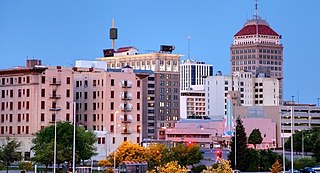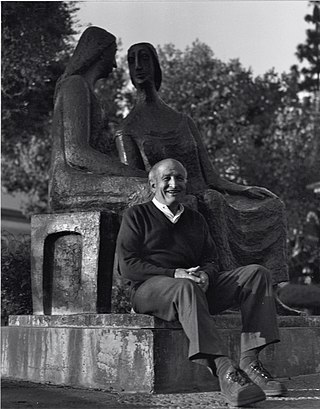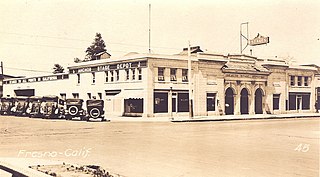
Fresno is a major city in the San Joaquin Valley of California, United States. It is the county seat of Fresno County and the largest city in the greater Central Valley region. It covers about 115 square miles (300 km2) and had a population of 542,107 in 2020, making it the fifth-most populous city in California, the most populous inland city in California, and the 34th-most populous city in the nation. The Metro population of Fresno is 1,008,654 as of 2022.

The Corcoran Gallery of Art was an art museum in Washington, D.C., United States, that is now the location of the Corcoran School of the Arts and Design, a part of the George Washington University.
Santa Rosa Junior College (SRJC) is a public community college in Santa Rosa, California with an additional campus in Petaluma and centers in surrounding Sonoma County. Santa Rosa Junior College was modeled as a feeder school for the University of California system. SRJC is operated by the Sonoma County Community College District.

The California Science Center is a state agency and museum located in Exposition Park, Los Angeles, next to the Natural History Museum of Los Angeles County and the University of Southern California. Billed as the West Coast's largest hands-on science center, the California Science Center is a public-private partnership between the State of California and the California Science Center Foundation. The California Natural Resources Agency oversees the California Science Center and the California African American Museum. Founded in 1951 as the "California Museum of Science and Industry", the Museum was remodeled and renamed in 1998 as the "California Science Center". The California Science Center hosts the California State Science Fair annually.

The Children’s Museum of Manhattan is located on the Upper West Side of Manhattan in New York City. It was founded by Bette Korman, under the name GAME, in 1973. The museum became the Children’s Museum of Manhattan in the 1980s and moved to its current location on West 83rd Street in 1989. In 2018, the museum announced a plan to relocate to a larger space on 96th Street and Central Park West.

San Joaquin College of Law (SJCL) is a private law school in Clovis, California.
The MIT Museum, founded in 1971, is located at the Massachusetts Institute of Technology in Cambridge, Massachusetts. It hosts collections of holography, technology-related artworks, artificial intelligence, architecture, robotics, maritime history, and the history of MIT. Its holography collection of 1800 pieces is the largest in the world, though not all of it is exhibited. As of 2022, works by the kinetic artist Arthur Ganson are the largest long-running displays. There is a regular program of temporary special exhibitions, often on the intersections of art and technology.

The Santa Fe Passenger Depot, also known as Fresno station, is an historic railroad station and transportation hub in downtown Fresno, California. It is served by San Joaquins inter-city passenger trains, Greyhound inter-city buses, and regional transit services including Fresno Area Express, Fresno County Rural Transit Agency, and seasonally by the Yosemite Area Regional Transportation System.

Kidspace Children's Museum is a children's museum in Pasadena, California. It is located next to the Rose Bowl, in the former Fannie E. Morrison Horticultural Center.

The House of Charm is a historic museum building in Balboa Park, San Diego. It was built for the 1915–16 Panama-California Exposition, and like most buildings from that Exposition it features Mission Revival Style architecture. It acquired its current name, "House of Charm", during the park's second Exposition held in from 1935 to 36. It now houses the San Diego Art Institute and the Mingei International Museum as well as rehearsal space for the Old Globe Theatre. It is listed on the National Register of Historic Places.

The Exploratorium is a museum of science, technology, and arts in San Francisco, California. Characterized as "a mad scientist's penny arcade, a scientific funhouse, and an experimental laboratory all rolled into one", the participatory nature of its exhibits and its self-identification as a center for informal learning has led to it being cited as the prototype for participatory museums around the world.

The Fulton Mall was a six-block corridor in downtown Fresno, California which was closed to traffic in 1964 and made into a pedestrians only mall. Despite opening to much fanfare, the downtown mall suffered from the city's suburban expansion, especially the opening of the Fashion Fair Mall six miles to the north. By the 1980s, most storefronts on the mall were empty and plans to renovate the mall were discussed. In 2017, car traffic was reintroduced to the street after most the public art and amenities had been relocated to sidewalk areas.

Clement Renzi was an American sculptor whose figurative bronze and terra cotta works depict people, human relationships, animals, and birds. His work has been popular with collectors in California's Central Valley and is placed in more than 60 public venues, primarily in that region.

The Fresno Bee Building is an historic 5-story building located at Van Ness and Calaveras Street in downtown Fresno, California. It was built in 1922 by architect Leonard F. Starks to house the offices and printery for The Fresno Bee newspaper.

Arthur Dyson is an American architect.

The Fresno Art Museum is an art museum in Fresno, California. The museum's collection includes contemporary art, modern art, Mexican and Mexican-American art, and Pre-Columbian sculpture.

The Peerless Building, at 1755 Broadway Street in Fresno, California, was built in 1935. Originally built for pump manufacturing, sales and service, it was renovated and reopened 2018 as a mixed-use commercial space.

The Rusitigian Building, at Fulton and Mono Streets in Fresno, California, was built in 1920 in Classical Revival style architecture. Originally built as a bus depot, it was renovated and reopened 2019 for retail and restaurant tenants. It is listed as a historic place by Fresno's Local Register of Historic Resources.




















